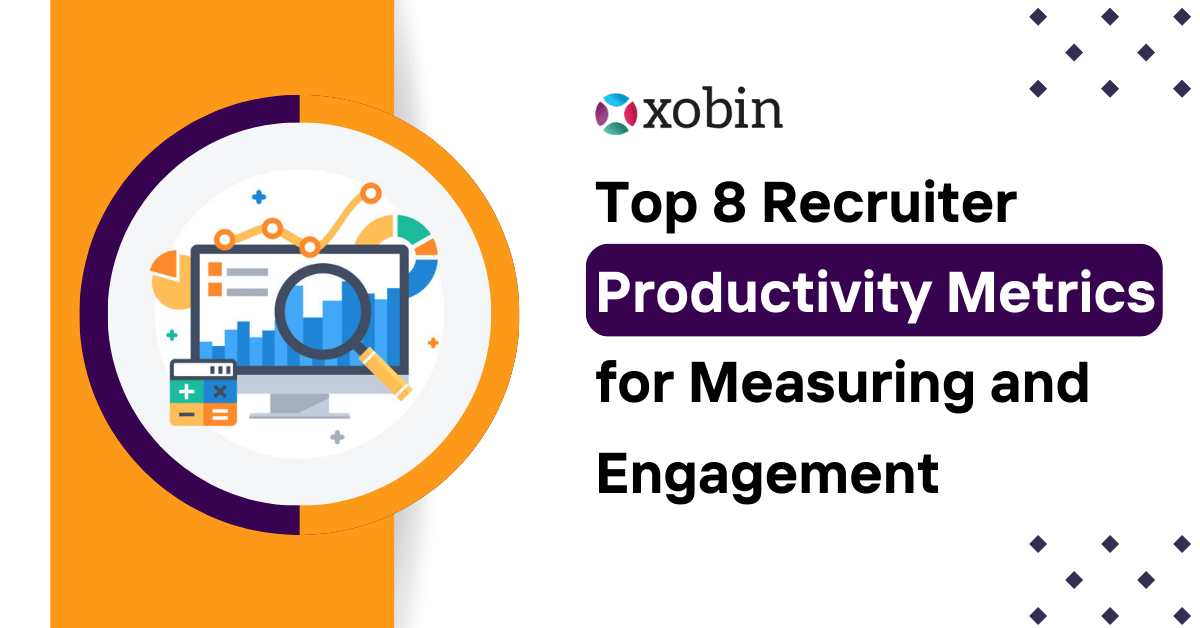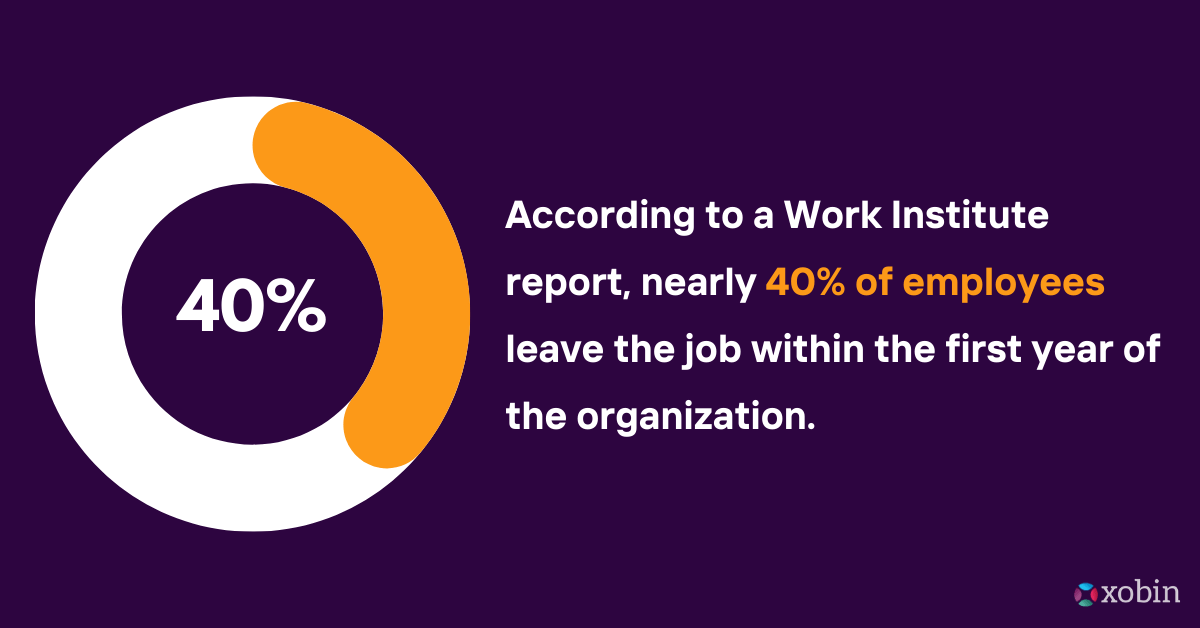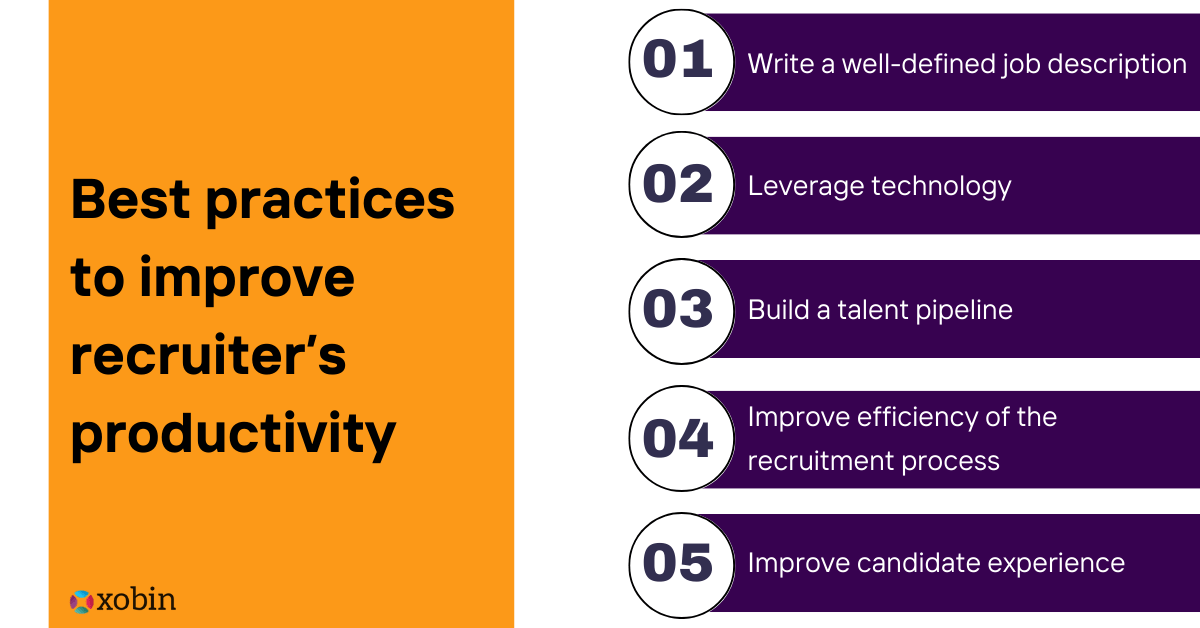
82% of executives say that HR metrics are useful for their organization. Recruiters also agree with it because you cannot improve what you cannot measure. Industry leaders have been saying for a while now it has become mandatory to streamline the HR processes and establish KPIs and recruiter productivity metrics to improve the functioning of the HR department. In today’s candidate-driven, competitive market, recruitment has become a major cost.
Also, surveys have found that more than half of the time spent in the recruitment process can be eliminated. So, setting up HR metrics is a great way to streamline your HR processes and make sure it function efficiently.
Looking for Recruitment Software? Check out the best recruitment software.
In this post, we will talk about what are recruiter productivity metrics are, the top productivity metrics for HRs, and the best practices to improve productivity so that you have a clear picture of how to proceed further.
What are recruiter productivity metrics?
Like any other metrics, recruiter productivity metrics provide key data points to measure how effective human resource functions are in the organization.
The goal of every recruitment department is to hire the best talent in the shortest possible time. Productivity metrics tell you how efficient and productive your HR department is in comparison to the industry standards or set parameters. It provides you with plenty of data-driven insights to make informed decisions.
Top recruiter productivity metrics to measure:
1. Time to hire:
It talks about the number of days it takes to hire a candidate. The time is usually measured from job requisition to a candidate accepting the role. According to the SHRM, a new position takes an average of 27 days to fill. And 85% of companies say their average hiring time is four weeks or less. So, if you are hiring an employee in less than four weeks, it shows your recruitment process is efficient and on par with industry standards.
2. Applicant-to-hire ratio:
It talks about the number of applicants who applied for the job position compared to the number of openings for the position. According to the Forbes report, 118 people apply for any given job. However, it depends on various factors, such as employer brand, the salary offered, market dynamics, and how the job is advertised.
This metric gives you a fair idea of how to craft the screening process of your organization. Organizations with a high applicant-to-hire ratio use additional criteria like pre-employment tests to filter through candidates and use applicant tracking systems (ATS) to focus on the most qualified candidates. It helps you save time and money and make the most of your HR resources. CMO search firms play a pivotal role in helping organizations optimize their hiring processes. They bring a unique perspective to candidate selection, enhancing the effectiveness of pre-employment tests and ATS usage. By collaborating with CMO search firms, businesses can streamline their screening process, reducing costs and maximizing HR resources.
3. Interview-to-offer ratio:
The interview-to-offer ratio talks about the number of people interviewed by the hiring team to extend one offer. A higher interview-to-offer ratio signifies lapses in the screening process, as the recruitment department is not screening qualified candidates.
A study by the NACE (National Association of Colleges and Employers) reveals, the average interview-to-offer rate is 47.5%—approximately 48 offers are made for every 100 candidates interviewed, which makes an average interview-to-offer ratio about 2:1.
But, it can be as high as 10:1, depending on the industry. A ratio of 3:1 is a good ratio. If your organization has a lower ratio, it indicates your recruitment process is effective in attracting and screening qualified candidates.
4. Offer acceptance rate:
It talks about the percentage of candidates who accepted a formal job offer. Not all candidates accept the offer. A high offer acceptance rate depicts the candidates’ expectations are met by the company’s offerings. It shows the recruiter has advertised the job requirements correctly, screened the right candidates, and extended an offer to the right candidate.
An offer acceptance rate of 90% is what organizations should aim for.
5. Cost per hire:
Cost per hire talks about the cost of hiring an employee. It takes everything into account, from advertising to salaries and tools per candidate you hire. A lower cost per hire signifies that your recruitment process is productive and cost-effective. In the United States, the median cost per hire is $1,633. However, it varies based on the experience level.
Best HR Software Solutions
Campus Recruitment Software
With our online campus recruitment software screen, hire top talents hassle-free. Everything is under one platform, from test creation to the candidate's evaluation.
Rating 5.0
Based on 321 user ratings
API Integration by Xobin
Get integrated and harness the strength of robust assessments with Xobin APIs. Save sweat and time and focus on your core offering, not building your assessment stack.
Rating 5.0
Based on 321 user ratings
Coding Skill Assessment Software
With our 100+ coding assessments on various languages such as Java, Python, JavaScript, React, Angular, etc., evaluate and hire the best-talented developers.
Rating 5.0
Based on 321 user ratings
Pre-Employment Testing Software:
Get access to the vast library of validated tests to screen candidates using online assessments. Simplify your recruitment process with our cloud-based Pre-employment Testing Software.
Rating 5.0
Based on 321 user ratings
For an entry-level employee, it is estimated to be about 20% of that employee’s salary whereas for senior-level employees it can be 3-4 times of position salary.
6. Source of hire:
This is one of the most useful recruiter productivity metrics that tell about where your top talent is coming from. You will be advertising positions on Linkedin, job portals, and company websites, or getting referrals from existing employees. By providing insights, it tells you where to channel your advertising efforts and make recruiters more productive.

7. Quality of hire:
Quality of hire is the most important metric, as it gives direct insight into how successful the recruitment process is. It takes into account various factors such as employee satisfaction, job performance, and job retention. Measuring these factors help you avoid a bad hire.
According to a Work Institute report, nearly 40% of employees leave the job within the first year of the organization. If you have a low attrition rate of 10% or less and the candidate is performing as per expectations, it shows you have hired the right candidate.
8. Candidate experience:
It talks about how satisfied candidates are with the recruitment process. You can use the commonly used Net Promoter Score (NPS) to gauge candidate satisfaction with the recruitment process. A poor score means your recruitment process is not candidate-friendly and you may lose on great talent because of that. A candidate NPS score of 7 or above out of 10 would be a good score.
Now, let’s look at some of the best practices that will you improve productivity and overall work engagement.
Best practices to improve recruiter’s productivity and work engagement:
There are plenty of challenges in front of recruiters. Some challenges are controllable, while others are not. On top of that, there is enormous pressure on recruiters to hire the best candidate and hire them fast.
However, setting a few things right helps recruiters improve productivity significantly, enhance work engagement, and reduce pressure. Here are some key tips:

1. Write a well-defined job description:
The first step to make improvements is to write a clear and attractive job posting. It will help you attract the right candidate and prevent wasting time on screening unqualified applications. So, your job description should include complete information: job title and work experience requirements, the job responsibilities, must-have skills & nice-to-have skills, the compensation you are offering, and what makes your company unique.
Use clear and simple language so that your candidate does not have to do the guesswork.
2. Leverage technology:
Still, a significant share of recruiters wastes time on repetitive and time-consuming tasks, such as sending confirmation emails, making phone calls to schedule meetings, keeping track of the candidates manually, and onboarding tasks. You can leverage technology to optimize your recruitment process to maximum efficiency and reduce the pressure from the recruiters.
Use various tools such as:
- an applicant tracking system to manage candidates
- online appointment scheduling tools to automate interview scheduling
- skill assessment tools to help you with screening and interviewing
- onboarding tools to help candidates get started
- work management software to streamline and track work in order to make comparisons with metrics
The top tools that can make part of your HR stack for an efficient and cost-effective hiring process are Xobin, Calendly, ProofHub, and Mailchimp.
3. Build a talent pipeline:
According to the recruitment platform Monster’s global report of The Future of Work, more than 9 out of 10 employers say they are struggling to fill positions because of a skills gap.
Keep constantly filling your talent pipeline. You can utilize various sources to have lots of candidates at any given time in your pipeline, such as:
- past candidates who didn’t get hired but can be in the future, former employees, and interns
- source passive candidates
- quality candidates from various sources such as LinkedIn, references from existing employees, and job portals
4. Improve efficiency of the recruitment process:
There is a lot of space for standardization and automation in the recruitment process. You can improve operational efficiency by automating repetitive tasks, using standard evaluation templates for each role, and documenting the entire process by building checklists. It will help your recruitment team save time and money.
5. Improve candidate experience:
Job applications should be easy to fill and short because candidates do not like lengthy application processes and give up halfway through if it demands effort. Take steps to improve candidate experience. Shorten your application process, make it easy to apply for the candidates, and keep the candidate engaged and informed throughout the process.
These practices will help you make improvements in the recruitment process.
Wrapping up:
Every CEO wants to have the most effective recruitment process — where the best talent is hired in the minimum possible time. But, it can happen only when you have the right tools, practices, and resources at the place. Having well-defined recruiter productivity metrics designed as per your industry and the organization is a great start to optimizing your recruitment process.
It will help you lower your recruitment costs, hire the best possible candidates, and improve the performance, work efficiency, and engagement of the recruitment department.
Software You Need For All Your Recruitment Needs
Rating 4.9
2 Million
Candidates screened
1200
Customers
Author Bio – Vartika Kashyap is the chief marketing officer at ProofHub, a powerful Clickup Alternatives. She is a strong-headed woman who always puts her innovative inputs into project management, collaboration, balancing work and life with technology and more. She is active on various platforms, including Linkedin, the e-learning industry, and more, to share her expertise. Off hours, she enjoys motherhood and reading about mental well-being.


